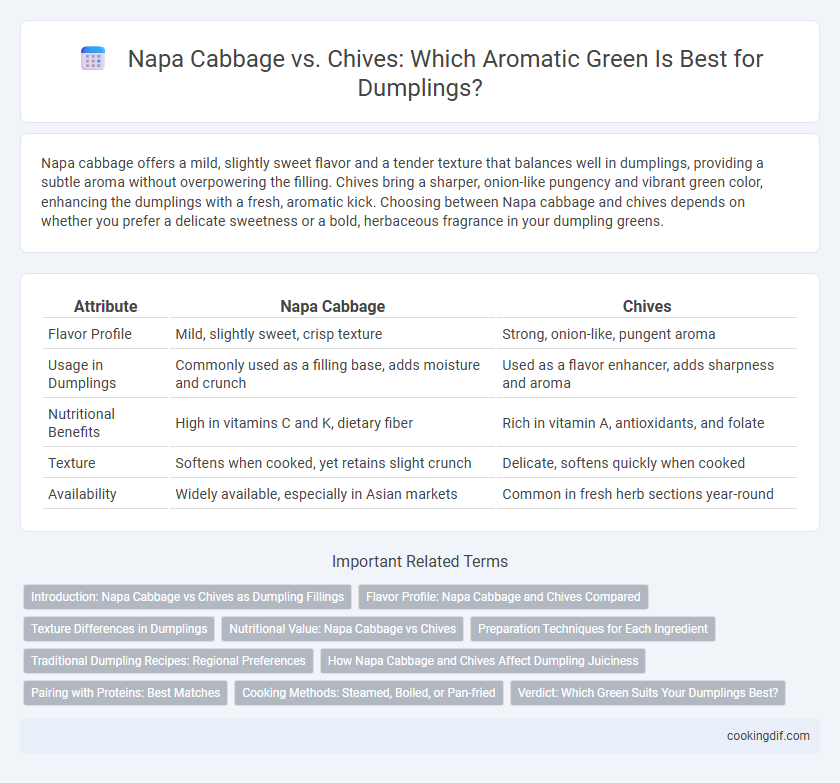Napa cabbage offers a mild, slightly sweet flavor and a tender texture that balances well in dumplings, providing a subtle aroma without overpowering the filling. Chives bring a sharper, onion-like pungency and vibrant green color, enhancing the dumplings with a fresh, aromatic kick. Choosing between Napa cabbage and chives depends on whether you prefer a delicate sweetness or a bold, herbaceous fragrance in your dumpling greens.
Table of Comparison
| Attribute | Napa Cabbage | Chives |
|---|---|---|
| Flavor Profile | Mild, slightly sweet, crisp texture | Strong, onion-like, pungent aroma |
| Usage in Dumplings | Commonly used as a filling base, adds moisture and crunch | Used as a flavor enhancer, adds sharpness and aroma |
| Nutritional Benefits | High in vitamins C and K, dietary fiber | Rich in vitamin A, antioxidants, and folate |
| Texture | Softens when cooked, yet retains slight crunch | Delicate, softens quickly when cooked |
| Availability | Widely available, especially in Asian markets | Common in fresh herb sections year-round |
Introduction: Napa Cabbage vs Chives as Dumpling Fillings
Napa cabbage and chives provide distinct aromatic profiles and textures as dumpling fillings, influencing the overall flavor balance. Napa cabbage offers a mild, slightly sweet crunch that retains moisture during cooking, enhancing juiciness. Chives contribute a sharp, onion-like aroma that intensifies savory notes and adds a subtle zing to the dumpling's taste.
Flavor Profile: Napa Cabbage and Chives Compared
Napa cabbage offers a mild, slightly sweet flavor with a delicate crunch that adds subtle freshness to dumplings, making it ideal for those preferring a gentle aromatic base. Chives contribute a sharp, onion-like zest with a hint of garlic, enhancing dumplings with a bold, savory punch that intensifies the overall flavor profile. Combining both creates a balanced mix where Napa cabbage provides texture and sweetness while chives deliver a vibrant, aromatic lift.
Texture Differences in Dumplings
Napa cabbage offers a tender, slightly crunchy texture that softens delightfully when steamed, providing a juicy bite in dumplings. Chives contribute a firmer, fibrous texture with a subtle snap, adding a distinct contrast to the soft dumpling wrapper. Combining both enhances textural complexity, balancing Napa cabbage's softness with chives' crispness for an optimal dumpling filling experience.
Nutritional Value: Napa Cabbage vs Chives
Napa cabbage contains high levels of vitamin C, vitamin K, and dietary fiber, providing antioxidants and supporting digestion. Chives are rich in vitamin A, vitamin C, and folate, delivering potent antioxidants and promoting immune function. Both greens enhance dumpling nutrition, with Napa cabbage offering more fiber and chives providing higher vitamin A content.
Preparation Techniques for Each Ingredient
Napa cabbage requires thorough washing and thin slicing to maintain its tender texture and mild flavor in dumplings, often being lightly salted and drained to remove excess moisture. Chives need minimal preparation, typically trimmed and finely chopped to preserve their sharp, pungent aroma that enhances the overall filling. Both ingredients benefit from gentle incorporation to balance moisture levels and avoid soggy dumpling wrappers.
Traditional Dumpling Recipes: Regional Preferences
Traditional dumpling recipes often showcase regional preferences with Napa cabbage favored in northern Chinese varieties for its mild, slightly sweet flavor and tender texture that complements pork or vegetable fillings. Chives dominate in southern dumplings, particularly in Cantonese and Sichuan cuisines, offering a robust, garlicky aroma that enhances meat mixtures and balances richness. The choice between Napa cabbage and chives significantly influences the dumpling's aromatic profile, reflecting local agricultural availability and culinary heritage.
How Napa Cabbage and Chives Affect Dumpling Juiciness
Napa cabbage enhances dumpling juiciness by releasing water during cooking, creating a moist and tender filling, whereas chives contribute a subtle, aromatic flavor without adding significant moisture. The high water content in Napa cabbage helps maintain dumpling succulence, while chives primarily provide a fresh, pungent note that complements other filling ingredients. Combining both greens balances juiciness and aromatic complexity, resulting in flavorful and moist dumplings.
Pairing with Proteins: Best Matches
Napa cabbage offers a mild, slightly sweet flavor that pairs exceptionally well with pork and chicken, enhancing dumpling fillings without overpowering the protein's natural taste. Chives provide a sharp, onion-like aroma that complements beef and shrimp, adding a fresh, zesty note to the dumpling mixture. Choosing Napa cabbage or chives based on the protein helps balance flavors and elevate the overall taste profile of the dumplings.
Cooking Methods: Steamed, Boiled, or Pan-fried
Napa cabbage and chives each offer distinct flavors and textures when used as aromatic greens in dumplings, with cooking methods influencing their taste and tenderness. Steamed dumplings retain the crisp, mild sweetness of Napa cabbage while softening its leafy layers, whereas chives become tender and release their sharp, onion-like aroma. Boiling enhances the cabbage's moisture absorption, making it juicy, while pan-frying creates a caramelized contrast that intensifies the chives' pungency and the cabbage's subtle earthiness.
Verdict: Which Green Suits Your Dumplings Best?
Napa cabbage offers a mild, slightly sweet flavor and tender texture that complements dumpling fillings without overpowering other ingredients. Chives provide a bold, onion-like aroma and a crisp bite, enhancing dumplings with a distinct and vibrant herbal note. For a balanced, traditional taste, Napa cabbage suits most dumplings best, while chives work well when a sharper, more pronounced flavor is desired.
Napa cabbage vs Chives for aromatic greens Infographic

 cookingdif.com
cookingdif.com